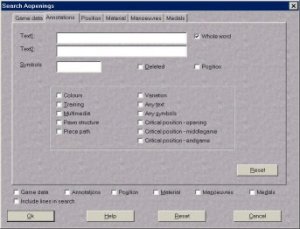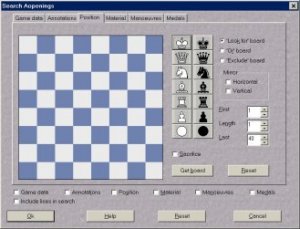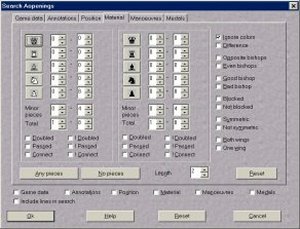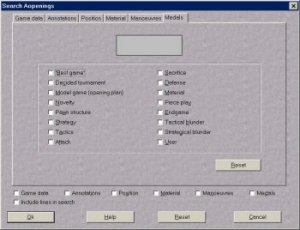 |
ChessBase Reviews |
Last updated 7 May 2001

| index | part 1 | part 2 | part 3 | part 4 | part 5 | part 6 | part 7 | part 8 |
ChessBase 8 Part 2
In this article I want to touch on some of the things that can be done with databases in ChessBase 8. First of all though, let's explain in layman's terms what a database is. A database is simply a collection of records containing various pieces of information. For example you may wish to set up a database containing information about friends and family. Each record may contain the following information: - Name, Address, Telephone Number, Email Address, Date of Birth, Likes/Dislikes or anything else you may wish to record. Fine, you can store that sort of information in a address book, but the point of a database is to make the information more readily available.
With a small database of say 20 records, you could simply flick from record to record to find out if anyone has a birthday coming up, but with say several hundred records or even thousands if you are popular, that would be impractical. That is where a database comes into its own, because you can set up a search to find out such information at the click of a mouse. So now you can instantly find out that little Johnny's birthday is next week without having to look at every record manually.
So that's the basics. Chess databases work in exactly the same way. A record will contain the moves of a game with any sub variations someone has recorded, the names of the players, when and where the game was played, the ECO code for the opening variation, any text annotations someone has added, and perhaps even some video annotations. The greater the number of games, the more information you have at your disposal, and therefore the greater the need for efficient search tools to be able to search for specific information. Fortunately that is exactly what ChessBase 8 provides and the ease with which you can retrieve information has to be one of the best reasons for buying ChessBase 8.
The most obvious search may be for example for games by a specific player or perhaps of a specific opening. This can be done by using the search mask and if you right click on any of the databases in your opening window, the drop down menu will allow you to select the search mask.
This is the first screen to pop up and is the Game data window. This is probably the most commonly used search facility. It can be used to enter for example the name of a player. Then simply clicking OK will begin the search and ChessBase will bring up a list of all the games for that player in that database. The other Tabs at the top of this box (Annotations, Position, Material, Manoeuvres and Medals) allow you to enter different search criteria.


Annotations
For example, here you could enter backward pawn in text 1 and hanging pawn in text 2 and the search would find all games containing either text string.
This is probably the second most common type of search that I use. You can set up a position manually by placing the pieces on the board. It need not be a complete position. You could set up a certain pawn structure with the kings on certain squares and the search would find all games that matched that criteria.
The other way to use this search mask is to click on get board. I have a separate small database which contains my games. I can open this database, load a game and play through to a certain position. By clicking on the ChessBase 8 bar in the tool bar at the bottom of the screen I can then right click on a larger database to launce the Search Mask. I then click on the Position Tab and click on Get board. The current position from the game I am looking at is then automatically loaded into the search mask. Once again the search will find all games in the database where that game has been reached.
To give you an idea of the power and speed of ChessBase 8 searches, imagine a database containing 1,000,000 games. If each game is on average 35 moves, that's 70 positions per game, giving 70,000,000 positions in the database, all of which ChessBase has to compare the entered position against to see if it matches. Depending on the speed of your PC this could be achieved in under 1 minute.


In this window, there is another interesting new possibility. Without setting anything on the board you can tick the little box which says Sacrifice. This cause a search for all games in which a sacrifice has been made. For example, a bishop is sacked for a pawn on h7. All games containing sacrifices will be found, but be warned ChessBase will find both good and bad ones. It's up to you to decide which is which if you want to try any of the ideas in your own games. Be warned though, this could be a time consuming search.
If you have a database of 1 million plus games, you could happily go away and leave the computer working all night to find all the sacrifices in that database. It's best to use this search on small games collections. If you are interested in finding sacs in a particular opening variation, I would advise that you create a small database containing only games of that variation and then do the search for sacrifices on that database.


Material
This is most useful for finding particular types of endgames you may wish to study. You would enter the minimum and maximum number you wanted for each piece. For example, you might want to examine 2 White rooks (minimum 2, maximum 2) and White pawns (for example minimum1 maximum 3), versus Black queen (minimum 1 maximum 1) and pawn (minimum 1 maximum1).
Manoeuvres
For example, this would allow you to search for games where a White bishop has moved from anywhere to capture a pawn on f7.
Medals
When entering games, some annotators may add medals for best game or mark a particular move as a Novelty. This mask allows you to search for games marked in this way.
The basic search mask isn't the end of the story. Double clicking on a Database opens the database and there are a whole other set of possibilities. These are covered in Part 3.